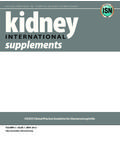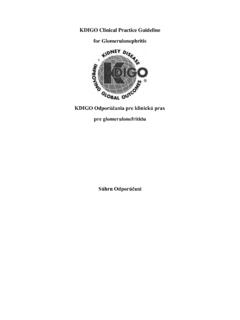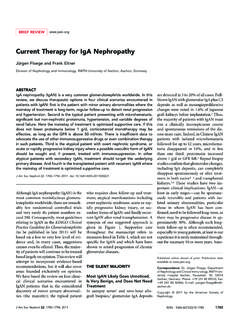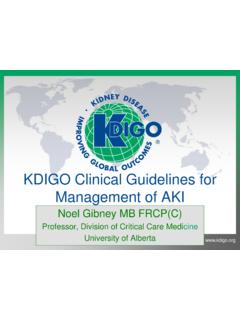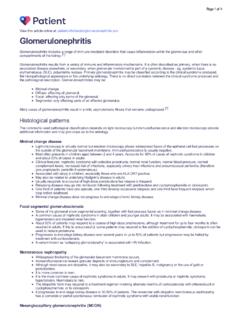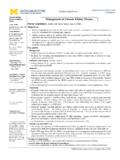Transcription of Kidney Case Conference: Nephrology Quiz and …
1 Kidney Case Conference: Nephrology Quiz and QuestionnaireAn Elderly Man with Fatigue, Dyspnea, and KidneyFailureAndrew S. BombackClin J Am Soc Nephrol12: 836 838, 2017. doi: most American Society of Nephrology (ASN) Kidney Week attendees, case-based clinical nephrologytalks are one of the most exciting venues. The Nephrol-ogy Quiz and Questionnaire (NQQ) is the essence ofclinical Nephrology and represents what drew all ofus into thefield of Nephrology . This year sNQQinsurprisingly temperate Chicago, with full-house atten-dance, was no exception. The expert discussants pre-pared vignettes of puzzling patients, which illustratedsome topical, challenging, or controversial aspect ofthe diagnosis or management of key clinical areas ofnephrology. These eight interesting patients werepresented and eloquently discussed by our four expertASN faculty. Subsequently, each discussant prepareda manuscript summarizing his or her case discussions,which serves as the text of this article (Mark and Michael Choi, comoderators).
2 Patient PresentationA 76-year-old man reports to his primary carephysician that he has been feeling more fatigued thanusual. He also complains of feeling cold and havingchills ( like I have theflu ) and has an unintentional15-pound weight loss over the previous month. In thelast week, he has developed a new cough and someshortness of breath with exertion. His medical historyincludes coronary artery disease requiring percutaneouscoronary intervention, systolic heart failure (ejectionfraction of 45%), chronic obstructive pulmonary dis-ease, hypertension, and hyperlipidemia. His medica-tions have not changed recently and include mg daily, hydralazine 25 mg three times daily,carvedilol mg twice daily, aspirin 81 mg daily, andatorvastatin 80 mg daily. His primary care physiciansends him to the emergency room for further the emergency room, his examination is notable fornormal BP, mild conjunctival injection, decreased breathsounds at bilateral bases, and trace nonpitting edema.
3 Achest radiograph shows bilateral hazy opacities. Labora-tory tests reveal serum creatinine of mg/dl, hemoglo-bin g/dl, and urinalysis with 31blood and renal ultrasound shows no evidence of hydro-nephrosis. After repeat laboratory values confirm theseabnormal results, he is transfused 2 U packed red bloodcells, and a number of serologic tests are sent to work upthe Kidney failure. A kidneybiopsy is performed the fol-lowing day, with most of these tests pending. The biopsyshows a pauci-immune necrotizing and crescentic 1If hydralazine-induced vasculitis is suspected, whatserology result would you expect tofind in this patient?A. Positive proteinase3 (PR3)-ANCA, high titerB. Positive myeloperoxidase (MPO)-ANCA, high titerC. Negative MPO-ANCA and negative PR3-ANCAD. Positive antidouble-stranded DNA (anti-dsDNA)antibodyE. Positive antihistone antibodyDiscussion of Question 1 Patients with a drug-induced ANCA-associated vas-culitis usually manifest very high titers of MPO-ANCA(answer B is correct).
4 Drug-induced ANCA-associatedvasculitis has been reported with a number of agents(Table 1), with the strongest associations found inpatients using hydralazine, minocycline, and antithy-roid drugs (propylthiouracil, methimazole, andcarbimazole). Of these, hydralazine is the most com-monly reported agent to induce ANCA-associated vas-culitis (1,2). In a series from the Massachusetts GeneralHospital of 30 patients withANCA-associated vasculitisand the highest anti-MPO titers (ranging from 3087 to141,409 AU/ml), ten had been exposed to hydralazine,three had been exposed to propylthiouracil, two hadbeen exposed to penicillamine, two had been exposed toallopurinol, and one had been exposed to sulfasalazine(3). A small number of patients with drug-inducedvasculitis present with PR3-ANCAs, although theseantibodies are more commonly seen in conjunctionwith significantly higher titers of anti-MPO can also induce a lupus syndrome withantibodies to dsDNA and antihistone antibodies, andpatients with overlap cases of hydralazine-inducednecrotizing and crescentic lupus nephritis with(1)MPO-ANCA serologies have been reported (4).
5 These patients, however, do not have pauci-immunestaining on immunofluorescence microscopy but rather,stain positive for Ig and complement typical of lupusnephritis. Positive antihistone antibodies have beenDivision ofNephrology,Columbia UniversityCollege of Physiciansand Surgeons, NewYork, New YorkCorrespondence:Dr. Andrew , Division ofNephrology, ColumbiaUniversity, 622 West168th Street, New York,NY 10032. Vol 12 May, 2017836 Copyright 2017 by the American Society of Nephrologydetected in patients with hydralazine-induced ANCA vascu-litis, but this is not review of the literature, performed by Yokogawa andVivino (2) in 2009, found 68 reported patients with hydralazine-associated vasculitis. GN was a presenting feature patients. In terms of additional serologies, 96% of thesereported patients were antinuclear antibody positive, butonly 26% were anti-dsDNA positive.
6 The mean duration ofdrug exposure was years, and patients were taking anaverage dose of 142 mg/d, suggesting that drug-inducedvasculitis can occur even after longstanding use of theoffending agent and at relatively low doses. In the casepresented here, the patient had been on hydralazine forover 3 years on a current dose of only 75 and Niles (5) recently proposed an epigeneticexplanation for the mechanism underlying hydralazine-induced ANCA vasculitis. Recognizing the role in non-drug-induced ANCA-associated vasculitis of abnormalepigenetic modifications necessary for gene silencingaround MPO and PR3 loci (6), they noted a similarity inhow hydralazine can act as a synthetic non-nucleosideDNA methylation inhibitor to reverse epigenetic silencingof tumor-suppressor genes in cancer cells (7). Hydralazinemay, therefore, reverse epigenetic silencing of PR3 and MPO,resulting in increased expression of both autoantigens inneutrophils to break tolerance and induce formation ofdisease-causing anti-MPO and anti-PR3 MPO-ANCA titer in this patient returned very high(971 AU/ml; reference range 0 19), and PR3-ANCA wasalso positive at low levels (60 AU/ml; reference range 0 19), confirming a diagnosis of drug-induced and antihistone antibodies returned was discontinued.
7 Bronchoscopy with alveo-lar lavage revealed diffuse alveolar hemorrhage. The pa-tient was started on pulse steroids and 2 What, if any, further therapy would you recommend forthis patient?A. No additional immunosuppressionB. Mycophenolate mofetilC. Cyclophosphamide (intravenous or orally)D. RituximabE. AzathioprineDiscussion of Question 2 This patient should be treated with an immunosuppres-sive therapy in addition to the treatments already received,and cyclophosphamide has the strongest evidence basefor induction therapy in this setting (answer C is correct).Hydralazine-induced ANCA-associated vasculitis is frequentlyassociated with Kidney involvement a necrotizing andcrescentic GN with pauci-immune staining on immunoflu-orescence as in this patient with similar outcomes seen innondrug-associated forms of ANCA-associated crescenticGN. Therefore, in addition to withdrawal of the offendingdrug, immunosuppressive therapy is required to maximizekidney and overall survival.
8 In the above-mentioned seriesfrom the Massachusetts General Hospital, of the ten patientswith hydralazine-associated ANCA vasculitis, over a 6-monthfollow-up period, two died, and three required dialysis (ofwhich one remained dialysis dependent).The choice of immunosuppressive therapy in drug- andnondrug-induced ANCA-associated GN is the same. Manycenters will only use induction phase therapy withoutmaintenance immunosuppression if remission is achievedgiven that relapse of disease would not be expected as longas the patient is not re-exposed to the offending drug. Of thefour treatment choices offered for induction therapy ofANCA-associated GN, cyclophosphamide is the regimensupported by both the Kidney Disease Outcomes QualityInitiative and the Kidney Disease Improving Global Out-comes in practice guidelines (8,9). The guidelines do notspecifically endorse intravenous versus oral cyclophospha-mide, and the choice is generally center specific.
9 A random-ized clinical trial, conducted in 42 centers in 12 Europeancountries, showed similar efficacy between these regimens,with reduced cumulative doses and lower rates of neutro-penia using an intravenous regimen (10), but relapse rateswere approximately twice as high in subjects treated withintravenous cyclophosphamide compared with subjectstreated with oral cyclophosphamide in a subsequent reportwith long-term follow-up data from this trial (11).Mycophenolate mofetil and azathioprine, alone or inconjunction with steroids, are not induction regimens forANCA-associated GN but rather are used as maintenancetherapies for patients who have achieved remission. Rituximab,an mAb against CD20, is an approved induction therapyfor ANCA-associated GN on the basis of results from theRandomized Trial of RituximabVersus Cyclophosphamide inANCA-Associated Vasculitis (RITUXVAS) and the Rituxi-mab in ANCA-Associated Vasculitis (RAVE) Trials(12,13).
10 However, the current guideline recommendations are foruse of this drug in patients without severe disease or withclear contraindications to cyclophosphamide (8,9), neitherof which apply to our patient. Indeed, the subjects in theRAVE Trial, which compared rituximab with oral cyclo-phosphamide as induction therapy for ANCA-associatedGN (compare with intravenous cyclophosphamide givenwith rituximab in the RITUXVAS), had a mean age of 53years old and mean creatinine clearance of 62 ml/min atthe time of enrollment (13). In a subgroup analysis from theRAVE Trial looking only at the 52% (102 of 197) of theTable 1. Drugs reported to induce ANCA-associated vasculitisStronger Evidence BaseWeaker Evidence BaseHydralazinePenicillamineMinocyclineA llopurinolPropylthiouracilSulfasalazineM ethimazoleRifampicinCarbimazoleCefotaxim eLevamisole (CC)IsoniazidIndomethacinClozapinePhenyt oinStrength of evidence is on the basis of the number of publishedcases in the medical literature.



